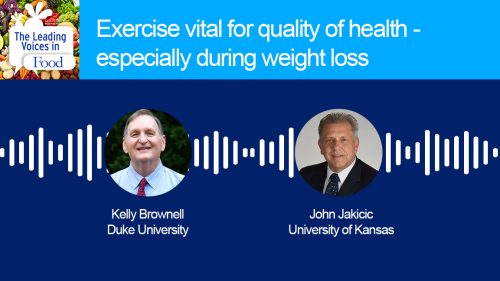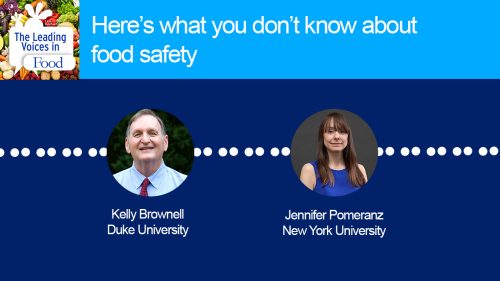The Leading Voices in Food
E189: FDA Plans to Update Health Claim on Food Packaging
Food packaging can make shopping a pretty difficult process. Packaging can be a blitz of marketing strategies, where fact and misdirection are hard to distinguish. Plainly put, food labels are often confusing for consumers. So what is the Food and Drug Administration doing about this? We’re happy today to have Dr. Susan Mayne join us. She is the director of the Center for Food Safety and Applied Nutrition at the FDA. She has done a lot of work on this topic.
Subscribe: Apple Podcasts | TuneIN | YouTube Music | SoundCloud | PocketCasts | Radio Public
Tags: Diet & Nutrition | Food Industry Behavior & Marketing |

Susan Mayne is the Director of the Center for Food Safety and Applied Nutrition (CFSAN) at the Food and Drug Administration (FDA). In this position, Dr. Mayne leads the Center’s development and implementation of programs and policies related to the safety and labeling of foods, food and color additives, and cosmetics. CFSAN’s responsibilities also include fostering the development of healthier foods and ensuring that consumers have access to accurate and useful information to make healthy food choices. An internationally recognized public health leader and scientist, Dr. Mayne received a B.A. in chemistry from the University of Colorado. She earned a Ph.D. in nutritional sciences, with minors in biochemistry and toxicology, from Cornell University. Dr. Mayne has conducted extensive research on food, nutrition, and health. She is author or coauthor of nearly 250 scientific publications and her work has been cited more than 17,000 times.
Interview Summary
Well, let’s jump right in. The FDA already has a definition for the “Healthy” claim on food packages. So why does it need to be updated?
You’re right. We already do have a regulatory definition for healthy, but it’s outdated and we need to update it to align with current nutrition science and the Dietary Guidelines for Americans. So for example, current dietary guidelines focus in on the importance of eating healthy dietary patterns and food groups that comprise them, the type of fat in the diet rather than the total amount of fat consumed, and limiting the amount of sodium and added sugars in the diet. The proposed definition is really consistent with that focus.
What are some examples of foods that could change from healthy to unhealthy or the reverse under the new definition?
Some examples of foods that could qualify under the new definition include things like healthier oils, like olive oil, and fatty fish like salmon that, under the older definition, had too much fat to qualify. Trail mix, for example, could also qualify as long as the ingredients don’t make it too high in added sugar. When the previous definition of healthy was put out, we didn’t have added sugar in the regulatory definition for that. Yogurt is another food that could qualify, but a lot of yogurt is highly sweetened so those products would need to meet our proposed limit for added sugar to bear that healthy claim.
This could be really big news and a lot of important foods could shift categories. Let’s talk about what this means for the actual words on package that a consumer might see. So if a food, before it would qualify for healthy claims and still does, or one now all of a sudden goes into that category, what kind of things can the company say? What kind of words would show up on a package?
Our proposal here is to use that same term, “healthy,” that can be used on food package labeling as it has been able to be used for the last couple of decades, but just give it a new meaning. And so one is the actual claim: “healthy.” The other thing we are doing at the same time is we are doing research on a healthy symbol that could also be used on a food package. And the thinking here is that symbols on the front of the pack could serve as a quick signal again for consumers who are trying to make choices about what types of products could help them put together healthy dietary patterns. Once this definition is finalized, companies could use the term, the claim, they could use the symbol if we finalize a symbol that would go along with it. And again, these are meant to be quick signals for consumers for how they can help choose foods to build healthy dietary patterns.
Now let me ask a little bit about the science of these kind of things. Given that there’s so many things that are being said on packages, do consumers pay attention to these kind of things? Does it matter whether a product says “healthy” or not? Is there some risk that people, some people at least, will assume that if the word “healthy” is on it, it’s not going to taste as good? How does this all work out in terms of impact on consumer purchasing decisions?
Consumers definitely pay attention to claims and things that are on food packaging. When we finalize the updated definition for healthy, we also want to do some consumer education so that consumers really understand what this healthy claim would mean. So from our perspective, the updated definition that we have proposed means that foods that would bear that claim contain a meaningful amount of food groups that we’re trying to encourage as part of the dietary guidelines. A meaningful amount of, for example, fruits and vegetables or whole grains or healthy oils or dairy, those are all food groups in the dietary guidelines. And those foods also would not have too much sodium, saturated fat, or added sugars. So, we would want to do education around that. But consumers can understand that choosing foods that bear that claim can help them put together healthy dietary patterns consistent with our dietary guidelines.
So one, theoretically, could deduce all this information from the existing nutrition facts panel if one were to spend enough time looking at it. So why would it be helpful for consumers to have this additional information?
One of the differences between the proposed definition for healthy and the nutrition facts panel is that the nutrition facts panel conveys really important information, but it’s nutrients only. With the updated definition that we have proposed, that’s giving consumers that these products contain a meaningful amount of a food group. And there is an additional piece of information that consumers would have, once we’ve updated the definition of healthy, that this contains a meaningful amount of the food group. What that means is you’re getting all those nutrients that come along with that food group, including things that might not be included in the nutrition facts label.
I’m imagining, as you proceed with this, that you involve various constituencies in the discussion. Scientists, obviously, who work on it, consumers, the food industry, etc. I’m interested in the challenges that the food industry faces in this. Are there things in particular that are important to them in this context?
As we finalize this, there will be significant engagement. Even the proposed definition was following significant input and engagement. We held a public meeting on healthy before we ever came to this proposal. So now that we have a proposal out, we have a public comment period and we encourage people to comment, I know we’ll get extensive comments coming in, and then we have to take into consideration all those comments before we finalize the definition for healthy.
Thank you for giving that description. I guess the ultimate hope here is that a change in labeling practices will in turn affect consumer decisions about what to purchase and what to eat. And this, in turn, will have an impact on health. Is there reason to hope that that causal chain will actually take place?
There is, and we know that food labeling can be a really powerful tool for change. It empowers consumers with information that they can use to choose healthier diets. That can be really helpful when people are comparing similar food products. But it’s powerful in another way. In addition to helping consumers make good choices, labeling has the potential to make foods healthier because it provides an incentive for food manufacturers to reformulate. Our goal is to create a healthier default so that all food options get healthier. This is critical in our work to help create healthier diets and reduce diet-related disparities. So we do know about the power of labeling and one great success is our influence in virtually eliminating artificial trans fat from the food supply. After trans fat was added to the nutrition facts label in 2006, it led to an 80% drop in intake of artificial trans fat through consumers choosing different options and industry reformulating. We have since taken additional actions, and these artificial trans fats have now essentially been removed from the food supply, likely averting tens of thousands of cases of heart disease and stroke. We’ve also seen the restaurant and fast food industries are offering lower calorie options after we required calories on menus and menu boards. And as a third example, added sugars are now on the nutrition facts label, and we have already started to see industry introducing new lower sugar options and we’re seeing the population’s intake of added sugars declining. But there’s still more progress needed here. But, I think those are key examples of the power of labeling to get to a healthier food supply and better public health.
I’m really happy you brought up trans fats as a precedent, because that really was a huge victory and it involved the elimination of something altogether. And I remember, at the time, the industry said it would be terrible for them because they wouldn’t be able to find alternatives and consumers wouldn’t like the taste of the reconfigured products. But none of that turned out to be true and it probably reassured the industry as well as protected the health of the public. That was a great success story and it’ll be interesting to see how it plays out with other things, like added sugar and salt. It’s really nice that you’re working on that and I really appreciate you talking about some of the things that FDA is doing. And thanks for your work as a public servant, I really appreciate it.
It’s my pleasure. We are very committed to public health and nutrition at FDA, and these are some of the tools and some of the approaches we’re doing to get to just that.






